Related Research Articles

Boca Raton, is a city in southern Palm Beach County, Florida. It was first incorporated on August 2, 1924, as "Bocaratone," and then incorporated as "Boca Raton" in 1925. The 2019 population estimated by the U.S. Census Bureau was 99,805. However, approximately 200,000 additional people with a Boca Raton postal address live outside of municipal boundaries, such as in West Boca Raton. As a business center, the city experiences significant daytime population increases. Boca Raton is 45 miles (72 km) north of Miami and is a principal city of the Miami metropolitan area, which had a population of 6,012,331 people as of 2015. It is known as one of the wealthiest places in South Florida.
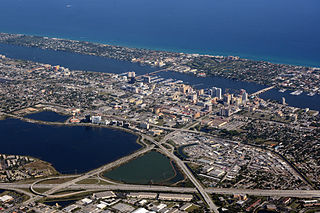
Palm Beach County is located in the southeastern part of the State of Florida and lies directly north of Broward County and Miami-Dade County. According to a 2019 census report, the county had a population of 1,496,770, making it the third-most populous county in the state of Florida and the 25th-most populous county in the United States. The largest city and county seat is West Palm Beach. Named after one of its oldest settlements, Palm Beach, the county was established in 1909, after being split from Dade County. The county's modern-day boundaries were established in 1963.
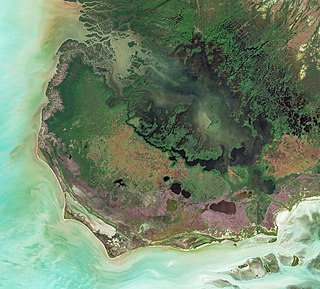
Cape Sable is the southernmost point of the United States mainland and mainland Florida. It is located in southwestern Florida, in Monroe County, and is part of the Everglades National Park.
The Lake Worth Lagoon is a lagoon located in Palm Beach County, Florida. It runs parallel to the coast, and is separated from the Atlantic Ocean by barrier beaches, including Palm Beach Island. The lagoon is connected to the Atlantic Ocean by two permanent, man-made inlets.

The Palm Beach Inlet, also known as the Lake Worth Inlet is an artificial cut through a barrier island connecting the northern part of the Lake Worth Lagoon in Palm Beach County, Florida with the Atlantic Ocean. It is bordered by the town of Palm Beach on the south, and by the town of Palm Beach Shores to the north. The inlet is also the entrance channel for the Port of Palm Beach. Its coordinates are 26°46′20″N80°02′14″W.

Upthegrove Beach is an unincorporated community in Okeechobee County, Florida, United States. It is located on US 441/US 98, on the northeastern shore of Lake Okeechobee.

Loxahatchee is an unincorporated community in Palm Beach County, Florida, United States, located in the areas north of Wellington and west and northwest of Royal Palm Beach and approximately 17 miles (27 km) west of West Palm Beach. Loxahatchee is also the name of the Post Office that serves this area, which is under the zip code of 33470.
The Boca Raton News, owned by the South Florida Media Company, was the local community newspaper of Boca Raton, Florida. The paper began publication December 2, 1955, with a startup circulation of 1200, published by Robert and Lora Britt, and edited by Margert Olsson. Initially a weekly publication, it later began daily operation.

The School District of Palm Beach County (SDPBC) is the tenth-largest public school district in the United States, and the fifth largest school district in Florida. The district encompasses all of Palm Beach County. For the beginning of the 2018–2019 academic year, enrollment totaled 192,533 students in Pre-K through 12th grades. The district operates a total of 180 schools: 109 elementary, 34 middle, 23 high, 14 alternative, adult and community, intermediate, and Exceptional Student Education (ESE). It has 27,168 employees and 45,000 volunteers.
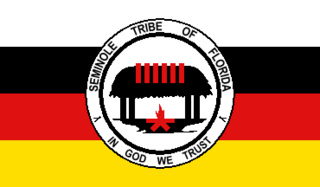
The Seminole Tribe of Florida is a federally recognized Seminole tribe based in the U.S. state of Florida. Together with the Seminole Nation of Oklahoma and the Miccosukee Tribe of Indians of Florida, it is one of three federally recognized Seminole entities. It received that status in 1957; today it has six Indian reservations in Florida.
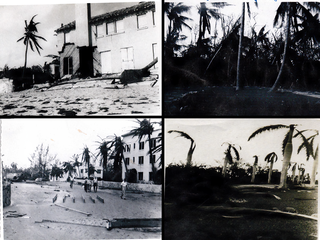
The effects of the 1947 Fort Lauderdale hurricane in Florida produced significant flooding, damage to vegetation, and beach erosion in the Miami metropolitan area. After forming off West Africa on September 2, the storm moved on a parabolic path that brought it through The Bahamas as a Category 3 hurricane on September 16, eventually striking the city of Fort Lauderdale in South Florida as a powerful Category 4 hurricane on the following day. The hurricane later crossed the state, entered the Gulf of Mexico near Naples less than 24 hours later, and went on to strike Louisiana before dissipating on September 21.
Everglades University, formerly known as the American Flyers College, is a private university with its main campus in Boca Raton, Florida, and several other campuses throughout the state. Everglades offers bachelor's and master's degree programs, both via online and on-campus.
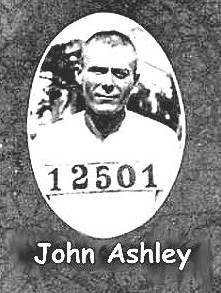
John Ashley was an American outlaw, bank robber, bootlegger, and occasional pirate active in southern Florida during the 1910s and 1920s. Between 1915 and 1924, the self-styled "King of the Everglades" or "Swamp Bandit" operated from various hideouts in the Florida Everglades. His gang robbed nearly $1 million from at least 40 banks while at the same time hijacking numerous shipments of illegal whiskey being smuggled into the state from the Bahamas. Indeed, Ashley's gang was so effective that rum-running on the Florida coast virtually ceased while the gang was active. His two-man raid on the West End in the Bahamas in 1924 marked the first time in over a century that American pirates had attacked a British Crown colony.

The Battles of the Loxahatchee occurred west of what is now Jupiter, Florida in January 1838 between the United States military and the Seminole Indians. The First Battle of the Loxahatchee occurred on January 15, involving a mixed Navy-Army unit under Lt. Levin M. Powell. The Second Battle of the Loxahatchee occurred on January 24 involving an army under Major General Thomas Jesup. The two battles were fought within a few miles of each other against the same group of Seminoles.
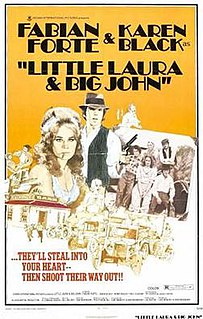
Little Laura and Big John is a 1973 American feature film about the exploits of the Ashley gang in the Florida everglades in the 1910s and 1920s.

Alfonso Fernando Gonzalez was a Florida Pioneer, Explorer and Steamship Captain, best known for his participation in an 1893 expedition through the Florida Everglades. Gonzalez was a son of Captain Manuel A. Gonzalez, who founded the City of Ft. Myers, Florida in 1866,

The effects of the 1928 Okeechobee hurricane in Florida included at least 2,500 fatalities in the state of Florida, making this the second deadliest tropical cyclone in the history of the contiguous United States, behind only the 1900 Galveston hurricane. The hurricane originated from a tropical depression that formed near Dakar, Senegal, on September 6. Traversing the Atlantic Ocean, the cyclone struck the Lesser Antilles, Puerto Rico, and the Bahamas as a powerful hurricane. Early on September 17, the storm made landfall near West Palm Beach, Florida, as a Category 4 hurricane on the modern day Saffir–Simpson hurricane wind scale. Thereafter, it moved further inland across the Southeastern United States and became extratropical over North Carolina on September 20, before the remnants lost their identity over Ontario on September 21.
Laura Beatrice Upthegrove was a 20th-century American outlaw, bank robber, bootlegger, and occasional pirate active in southern Florida during the 1910s and 1920s, along with John Ashley. From 1915 to 1924, the Ashley Gang operated from various hideouts in the Florida Everglades. The gang robbed nearly $1 million from at least 40 banks while at the same time hijacking numerous shipments of illegal whiskey being smuggled into the state from the Bahamas. Ashley's gang was so effective that rum-running on the Florida coast virtually ceased while the gang was active. Ashley's two-man raid on the West End, Grand Bahama, in 1924 marked the first time in over a century that American pirates had attacked a British Crown colony.
Louise Jones Gopher is the second Seminole and the first woman from the Seminole tribe of Florida to earn a bachelor's degree. Gopher, a former director of education for the Seminole Tribe of Florida, was the first female Seminole to earn a bachelor's degree when she graduated from Florida Atlantic University in 1970. Born May 25, 1945, in a chickee at a tribal camp in Fort Pierce, Jones spoke no English when she entered school at age 6. Because they were considered neither black nor white, none of the segregated schools of the day would willingly take her as a student, but at the pleading of her father, Lucie County Schools Superintendent Ben L. Bryan chose to allow her to enroll in the Fairlawn School. In 2014, she was granted an honorary Doctorate of Humane Letters from Florida State University. She is the third Seminole to receive an honorary degree from FSU, after Betty Mae Tiger Jumper and Jim Shore. The Palm Beach Post named her one of the most 100 influential people in Florida in the 20th century.
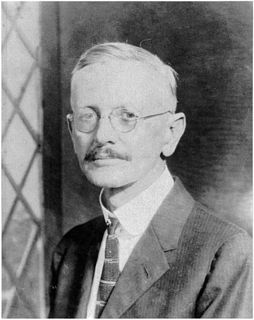
Charles William "Charlie" Pierce was one of South Florida's most important pioneer citizens. Arriving in 1872, Pierce was a community leader in banking, seamanship, the postal service, and author of the sentinel book on early South Florida life.
References
- ↑ Kleinberg, Elliot (7 March 2016). "South Florida's most wily gangster: John Ashley". Palm Beach Post. Retrieved 23 May 2016.
- ↑ Procyk, Richard. "The Ashley Gang and Frontier Justice". Jupiter, Florida. Retrieved 23 May 2016.
- ↑ Burnett, Gene M. Florida's Past: People and Events That Shaped the State. Vol. 3. Sarasota: Pineapple Press Inc, 1996. (pg. 85-89) ISBN 1-56164-115-4
- ↑ Moran, Mark, Charlie Carlson and Mark Sceurman. Weird Florida: Your Travel Guide to Florida's Local Legends and Best Kept Secrets. New York: Sterling Publishing Company, 2009. (pg. 101-104) ISBN 1-4027-6684-X
- ↑ "Indian Murder Launches Criminal Career". Seminole Tribe of Florida. Retrieved 23 May 2016.
- ↑ Report of the Secretary of State of the State of Florida for the period beginning January 1, 1911 and ending December 31, 1912. State of Florida.
- ↑ "Indian River Lagoon early 1900s - The Dreaded Ashley Gang". Archived from the original on 3 March 2016. Retrieved 23 May 2016.
- ↑ Annual Report of the Department of the Interior, 1916. US Department of the Interior. p. 51.
- ↑ Cole, Stephanie; Ring, Natalie J. The Folly of Jim Crow: Rethinking the Segregated South. A & M University Press. p. 64.
- ↑ Kleinberg, Eliot. Palm Beach Past: The Best of "Post Time". Charleston, South Carolina: The History Press, 2006. (pg. 72) ISBN 1-59629-115-X
- ↑ "A Desperado on the Florida frontier". 9 October 2007. Retrieved 23 May 2016.
- ↑ Blackburn, Doug (11 December 2014). "FSU honors Seminole legend Louise Gopher". Tallahassee Democrat. Retrieved 23 May 2016.